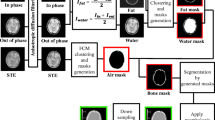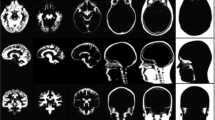Abstract
Purpose
The aim of this study is to introduce a fully automatic and reproducible short echo-time (STE) magnetic resonance imaging (MRI) segmentation approach for MR-based attenuation correction of positron emission tomography (PET) data in head region.
Procedures
Single STE-MR imaging was followed by generating attenuation correction maps (μ-maps) through exploiting an automated clustering-based level-set segmentation approach to classify head images into three regions of cortical bone, air, and soft tissue. Quantitative assessment was performed by comparing the STE-derived region classes with the corresponding regions extracted from X-ray computed tomography (CT) images.
Results
The proposed segmentation method returned accuracy and specificity values of over 90 % for cortical bone, air, and soft tissue regions. The MR- and CT-derived μ-maps were compared by quantitative histogram analysis.
Conclusions
The results suggest that the proposed automated segmentation approach can reliably discriminate bony structures from the proximal air and soft tissue in single STE-MR images, which is suitable for generating MR-based μ-maps for attenuation correction of PET data.






Similar content being viewed by others
References
Zaidi H, Montandon M-L, Slosman DO (2004) Attenuation compensation in cerebral 3D PET: effect of the attenuation map on absolute and relative quantitation. Eur Journal Nucl Med Mol Imaging 31:52–63
Zaidi H, Del Guerra A (2011) An outlook on future design of hybrid PET/MRI systems. Med Phys 38:5667–5689
Zaidi H (2007) Is MR-guided attenuation correction a viable option for dual-modality PET/MR imaging? 1. Radiology 244:639–642
Pichler BJ, Wehrl HF, Kolb A, Judenhofer MS (2008) Positron emission tomography/magnetic resonance imaging: the next generation of multimodality imaging? Semin Nucl Me 38:199–208P
Schlemmer H-PW, Pichler BJ, Schmand M et al (2008) Simultaneous MR/PET imaging of the human brain: feasibility study 1. Radiology 248:1028–1035
Wagenknecht G, Kaiser H-J, Mottaghy FM, Herzog H (2013) MRI for attenuation correction in PET: methods and challenges. Magn Reson Mater Phys Biol Med 26:99–113
Keereman V, Mollet P, Berker Y et al (2013) Challenges and current methods for attenuation correction in PET/MR. Magn Reson Mater Phys Biol Med 26:81–98
Navalpakkam BK, Braun H, Kuwert T, Quick HH (2013) Magnetic resonance–based attenuation correction for PET/MR hybrid imaging using continuous valued attenuation maps. Invest Radiol 48:323–332
Hofmann M, Pichler B, Schölkopf B, Beyer T (2009) Towards quantitative PET/MRI: a review of MR-based attenuation correction techniques. Eur Journal Nucl Med Mol Imaging 36:93–104
Akbarzadeh A, Ay MR, Ahmadian A et al (2013) MRI-guided attenuation correction in whole-body PET/MR: assessment of the effect of bone attenuation. Ann Nucl Med 27:152–162
Kops ER, Herzog H (2008) Template based attenuation correction for PET in MR-PET scanners. In: 2008 IEEE Nuclear Science Symposium Conference Record, IEEE, Dresden, Germany, pp 3786–3789
Malone IB, Ansorge RE, Williams GB et al (2011) Attenuation correction methods suitable for brain imaging with a PET/MRI scanner: a comparison of tissue atlas and template attenuation map approaches. J Nucl Med 52:1142–1149
Catana C, van der Kouwe A, Benner T et al (2010) Toward implementing an MRI-based PET attenuation-correction method for neurologic studies on the MR-PET brain prototype. J Nucl Med 51:1431–1438
Khateri P, Rad HS, Jafari AH et al (2015) Generation of a four-class attenuation Map for MRI-based attenuation correction of PET data in the head area using a novel combination of STE/Dixon-MRI and FCM clustering. Mol Imaging Biol 17:884–892
Hofmann M, Steinke F, Scheel V et al (2008) MRI-based attenuation correction for PET/MRI: a novel approach combining pattern recognition and atlas registration. J Nucl Med 49:1875–1883
Reza Ay M, Akbarzadeh A, Ahmadian A, Zaidi H (2014) Classification of bones from MR images in torso PET-MR imaging using a statistical shape model. Nucl Instrum Meth A 734:196–200
Keereman V, Fierens Y, Broux T et al (2010) MRI-based attenuation correction for PET/MRI using ultrashort echo time sequences. J Nucl Med 51:812–818
Khateri P, Rad HS, Fathi A, Ay MR (2013) Generation of attenuation map for MR-based attenuation correction of PET data in the head area employing 3D short echo time MR imaging. Nucl Instrum Meth A 702:133–136
Kazerooni AF, Ahmadian A, Saberi H, Alirezaie J, Rad HS (2012) An efficient algorithm for registration of pre-and intra-operative brain MRI images to correct intensity inhomogeneity. In: Information Science, Signal Processing and their Applications (ISSPA), 2012 11th International Conference, IEEE, Montreal, Canada, pp 253–258
Chan TF, Vese LA (2001) Active contours without edges. IEEE Trans Image Process 10:266–277
Ronfard R (1994) Region-based strategies for active contour models. Int J Comput Vision 13:229–251
Li C, Huang R, Ding Z, Gatenby J, Metaxas DN, Gore JC (2011) A level set method for image segmentation in the presence of intensity inhomogeneities with application to MRI. IEEE Trans Image Process 20:2007–2016
Van Leemput K, Maes F, Vandermeulen D, Suetens P (1999) Automated model-based bias field correction of MR images of the brain. IEEE Trans Med Imaging 18:885–896
Kazerooni AF, Aarabi MH, Ay M, Rad HS (2014) A fully automated and reproducible level-set segmentation approach for generation of MR-based attenuation correction map of PET images in the brain employing single STE-MR imaging modality. EJNMMI Physics 1:1–2
Aarabi MH, Kazerooni AF, Khateri P, Ay MR, Rad HS (2014) A robust MR-based attenuation map generation in short-TE MR images of the head employing hybrid spatial fuzzy C-means clustering and intensity inhomogeneity correction. EJNMMI Physics 1:1–2
Kazerooni AF, A’arabi MH, Ay M, Rad HS (2015) Generation of MR-based attenuation correction map of PET images in the brain employing joint segmentation of skull and soft-tissue from single short-TE MR imaging modality. In Computational Methods for Molecular Imaging. Springer, Switzerland 22: 139–147
Keereman V (2011) MRI-based attenuation correction for emission tomography. Ghent University, Ghent
Mohamed NA, Ahmed MN, Farag A (1999) Modified fuzzy c-mean in medical image segmentation [abstract]. Engin Med 6:3429–3432P
Hu Q, Qian G, Aziz A, & Nowinski WL (2006) Segmentation of brain from computed tomography head images. In: 2005 IEEE Engineering in Medicine and Biology 27th Annual Conference, IEEE, Shanghai, China, pp 3375–3378
An HJ, Seo S, Kang H, Choi H, Cheon GJ, Kim HJ (2016) MRI-based attenuation correction for PET/MRI using multiphase level-set method. J Nucl Med 57(4):587–593
Author information
Authors and Affiliations
Corresponding author
Ethics declarations
Study approval was obtained from the Medical Ethics Committee of Tehran University of Medical Sciences (License number 1432), and the subjects were included if they provided written informed consent.
Ethical Approval
All procedures performed in this study involving human participants were in accordance with the ethical standards of the Tehran University of Medical Sciences research committee with the Ethics License Number 1432.
Conflict of Interest
The authors declare that they have no conflict of interest.
Electronic Supplementary Materials
Below is the link to the electronic supplementary material.
ESM 1
(PDF 383 kb)
Rights and permissions
About this article
Cite this article
Fathi Kazerooni, A., Ay, M.R., Arfaie, S. et al. Single STE-MR Acquisition in MR-Based Attenuation Correction of Brain PET Imaging Employing a Fully Automated and Reproducible Level-Set Segmentation Approach. Mol Imaging Biol 19, 143–152 (2017). https://doi.org/10.1007/s11307-016-0990-5
Published:
Issue Date:
DOI: https://doi.org/10.1007/s11307-016-0990-5




